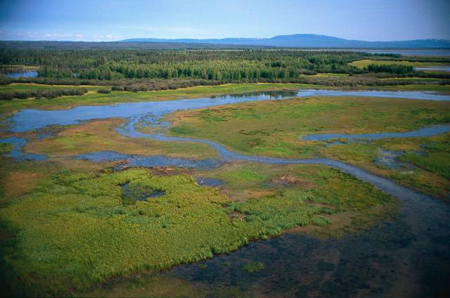
Peatlands in Canada's boreal forest.
Credit: Garth Lenz
Peatlands, those luxuriantly moss-capped, squishy, vast open spaces in the boreal underlain with yards-thick layers of undecomposed plant material, may not be the first habitats that people think of when talking about climate change. But they should be.
Though spanning only 3% of the Earth’s land area, peatlands store approximately 30% of all of the world’s terrestrial carbon. Despite being a tremendous (and natural) climate balancer, peatlands can release enormous quantities of greenhouse gasses when disturbed and altered.
This is why the work being done by the province of Manitoba, in coordination with local Indigenous groups and environmental organizations, is so substantial.
A little over a year ago, on the eve of the Copenhagen climate summit, Manitoba announced it was starting a new boreal peatlands stewardship strategy. The goal of this pilot program was to better study the size and values of Manitoba’s sprawling networks of peatlands, and ultimately protect a large portion of it from industrial activity. To show they weren’t kidding around, that same day they announced the protection of the Kaskatamagan Wildlife Management Area and Kaskatamagan Sipi Wildlife Management Area, totaling 988,000 acres of pristine forest and peatlands forever protected from industrial development.

The Palm Warbler is one of numerous bird species that stand to gain from Manitoba's boreal peatlands stewardship strategy.
Credit: Jeff Nadler
Since then the project has been moving forward slowly but surely. Late last month the province held a workshop, in conjunction with our Canadian partners Ducks Unlimited Canada and the Canadian Boreal Initiative, with experts and Indigenous representatives to discuss how the province can go about protecting its vast tracts of peatlands in an intelligent and meaningful way. One of the significant themes throughout this process, and rightly so, has been the recognition of Indigenous rights and the need to increase wilderness protection in a way that doesn’t impede their traditional ways of life. Just two days after the workshop the province announced the creation of Neultin and Colvin Lakes Provincial Parks, two new protected areas adding another 1.5 million acres toward their protection program. It was explicitly mentioned that Indigenous ways of life, including hunting, trapping, fishing, and generally subsiding off the land, would be allowed to continue.
These steps forward, and more importantly the strong vision being put forth for future generations, should be celebrated. These efforts are globally significant: Manitoba’s peatlands, according to Ducks Unlimited Canada, are estimated to be larger than New York, New Jersey, Massachusetts, and Maryland combined, and store approximately 19 billion metric tons of carbon dioxide – equivalent to nearly 100 years of Canada’s greenhouse gas emissions.
They also act as important habitat for iconic mammals like moose and caribou, and are home to millions of birds of numerous species. Some birds, such as the Solitary Sandpiper, Greater Yellowlegs, Lesser Yellowlegs, Short-billed Dowitcher, Palm Warbler, Wilson’s Warbler, Fox Sparrow, Lincoln’s Sparrow, and Rusty Blackbird are among many species that heavily rely on these intact peatlands and wetlands, having adapted perfectly for these unique types of ecosystems. Protecting these vast lands will ensure such birds will have healthy summer habitat upon their arrival from long migrations from the south.

